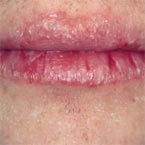What is angular cheilitis?
before you know Angular Cheilitis Treatment cheilitis is an inflammatory skin condition that occurs at the labial commissures, more commonly known as the corners of the mouth. This disorder is called several names like perleche, cheilosis, angular stomatitis, mouth corner cracks, and so on. It can occur on one side or both sides. The typical manifestation of the problem are deep splits and cracks, and sometimes, bleeding when ulcers or crusts have formed.
Why does angular cheilitis occur?
For most people, it starts with tiny cracks on the corners of the mouth. This happens when there’s an excess accumulation of saliva on those areas that leave the skin dry and prone to chapping. When more saliva gets into the area, bacteria and fungi can get inside. If the person’s immune resistance is not that strong, this can set off fungal or bacterial infection, which makes the cracks develop into open painful lesions.
How can anti-fungal treatment help?
Since fungi can be the root cause, it can help to combat these microorganisms with the use of anti-fungal creams. The use of anti-fungal creams with 1 percent hydrocortisone is usually advised by doctors. These creams are usually available over the counter.
before you know Angular Cheilitis Treatment may apply the cream on the affected area two to three times per day until the symptoms of pain, redness, and itchiness subside. It’s also an option to buy a cream that contains not only the anti-fungal hydrocortisone but also an anti-infective agent like iodoquinol to speed up the healing process.
Other anti-fungal treatments that are typically prescribed for the treatment of angular cheilitisinclude Mycolog-ll or Mycostatin, Nystatin, and steroids such as Triamcinolone acetonide. What these anti-fungal treatments do is that they kill the microorganisms that cause the problem. In the process, they help alleviate the symptoms of this condition.
Just be careful when using anti-fungal treatments. Since the ointment is applied near the mouth, it’s possible that it will get into your food or mouth. It’s also a must to avoid licking your lips so that you won’t get too much moisture on the corners of your mouth. Instead of licking your lips, try using a protective hypoallergenic lip balm.
A Quick but Definitive Guide to Angular Cheilitis or Perleche
Every important thing you need to know about angular cheilitis is included in this quick but definitive guide. If you or anyone you know is suffering from this frustrating skin condition, the first step in getting rid of the problem permanently is learning more about it.
Definition
Angular cheilitis refers to a chronic inflammatory condition of the skin that affects the labial commissures or the mouth corners. Apart from the French term “perleche,” it is also called by several other names such as cheilosis, angular stomatitis, and mouth corner cracks.
Causes
Any (or a combination) of the following can trigger the onset of this skin problem:
- Accumulation of saliva in the corners of the mouth
- Dry chapped lips
- Bacteria, yeasts, fungi or virus
- Skin conditions like contact dermatitis
- Habits that cause saliva accumulation or spread of bacteria or fungi (thumb-sucking, fingernail biting, use of pacifier and so on)
- Medical conditions that weaken the immune system
- Poor-fitting dentures
- Cold weather that causes skin dryness and chapping
before you know Angular Cheilitis Treatment a brief look at the top predisposing factors that put people at risk of angular cheilitis:
- Oral thrush in babies, elderly, diabetics, or people who use antibiotics
- Dentures
- Malnutrition (iron or riboflavin deficiency)
- Systemic ailments like Crohn’s disease and ulcerative colitis
- Sensitive skin
- Genetic predisposition
Angular cheilitis’ manifestations include the following:
- Cracks, splits and fissures on the corners of the mouth
- Pain, swelling, itchiness and bleeding in the affected areas
- Blisters, erosions and crusting
To diagnose angular cheilitis, a doctor will perform a culture test by taking a swab from the mouth corners. This will reveal the existence of microorganisms like Candida albicans and Staphylococcus aureus.
Treatment
The good news is, angular cheilitis can possibly go away on its own without treatment. But of course, since the symptoms are often painful and bothersome, you’d want to do something about it instead of just wait. These treatment methods have been proven effective in curbing this skin problem:
- Moisturizing lip balm
- Antibacterial medications
- Anti-fungal topical ointments
- Nutritional supplements

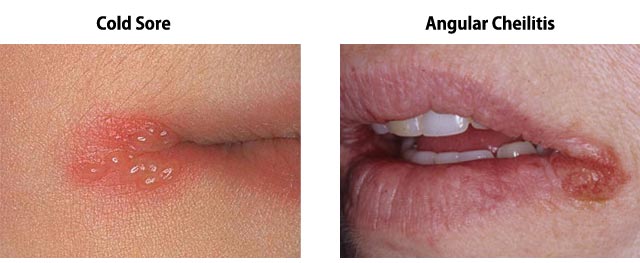

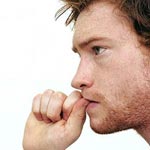 It's a fairly common habit for people to touch their mouths when
thinking, resting their head, etc. However, you should try to keep
yourself from touching your lips when you have angular cheilitis. The
reason is because our hands and fingers are extremely dirty and angular
cheilitis causes open wounds on your mouth. So every time you touch
your mouth with dirty finger you are potentially introducing new
bacteria to area making it more difficult for your body to heal itself.
If you must touch your lips, be sure to thoroughly wash your hands
before you do so.
It's a fairly common habit for people to touch their mouths when
thinking, resting their head, etc. However, you should try to keep
yourself from touching your lips when you have angular cheilitis. The
reason is because our hands and fingers are extremely dirty and angular
cheilitis causes open wounds on your mouth. So every time you touch
your mouth with dirty finger you are potentially introducing new
bacteria to area making it more difficult for your body to heal itself.
If you must touch your lips, be sure to thoroughly wash your hands
before you do so.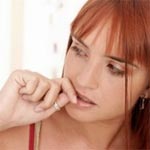 Yes, when your angular cheilitis begins to heal it looks gross and
unattractive. However, your hands are dirty so you should try your best
to not touch your wounds. Normally the best way to get rid of the
gross crust and flaky skin is to wash your hands, get a warm washcloth,
and gently rub it away. If you have angular cheilitis in both corners
of your mouth be sure to use a different wash cloth before cleaning the
other side to prevent spreading the bacteria across your mouth.
Yes, when your angular cheilitis begins to heal it looks gross and
unattractive. However, your hands are dirty so you should try your best
to not touch your wounds. Normally the best way to get rid of the
gross crust and flaky skin is to wash your hands, get a warm washcloth,
and gently rub it away. If you have angular cheilitis in both corners
of your mouth be sure to use a different wash cloth before cleaning the
other side to prevent spreading the bacteria across your mouth.
 Bleach is an extremely corrosive chemical that will irritate skin, eyes,
and your respiratory system. Toxic exposure to bleach has been linked
to many life-long health issues. Many hospitals and doctors offices may
use wound cleaners with a partial-bleach base to treat serious wounds,
however this does not mean it should ever be used for medical purposes
at the home other than disinfecting cleaning utensils and clothing.
Bleach is an extremely corrosive chemical that will irritate skin, eyes,
and your respiratory system. Toxic exposure to bleach has been linked
to many life-long health issues. Many hospitals and doctors offices may
use wound cleaners with a partial-bleach base to treat serious wounds,
however this does not mean it should ever be used for medical purposes
at the home other than disinfecting cleaning utensils and clothing.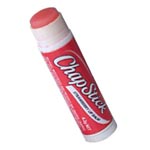 To prevent contaminating the chapstick/lip-balm you will need to apply
the balm to your lips with clean fingers. Get enough of the balm on
your finger that you don't have to re-apply it to your finger after you
touch your lips (if you need to do this, use a different finger or wash
your hands before doing so). When applying it to your lips, start in
the middle of your lip and work towards your mouth corners. This way
you will end at your mouth corner which prevents you from spreading the
angular cheilitis bacteria and fungus across your mouth.
To prevent contaminating the chapstick/lip-balm you will need to apply
the balm to your lips with clean fingers. Get enough of the balm on
your finger that you don't have to re-apply it to your finger after you
touch your lips (if you need to do this, use a different finger or wash
your hands before doing so). When applying it to your lips, start in
the middle of your lip and work towards your mouth corners. This way
you will end at your mouth corner which prevents you from spreading the
angular cheilitis bacteria and fungus across your mouth.
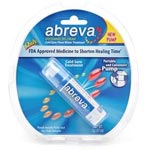 Many people think they have angular cheilitis when they actually have a
cold sore. So they will oftentimes swear that cold sore medications
work. However, they do nothing for angular cheilitis. In fact, most
cold sore medications contain a drying agent which may dry the skin on
your lips even more.
Many people think they have angular cheilitis when they actually have a
cold sore. So they will oftentimes swear that cold sore medications
work. However, they do nothing for angular cheilitis. In fact, most
cold sore medications contain a drying agent which may dry the skin on
your lips even more.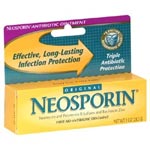 Neosporin is intended to treat minor cuts, scrapes, and burns and should
not get in your mouth. Angular cheilitis is a bacterial/fungal
infection on very close to your mouth. The only positive use Neosporin
should have for angular cheilitis is it can help to prevent scarring on
the outside of your mouth in cases where the lesions become severe and
split.
Neosporin is intended to treat minor cuts, scrapes, and burns and should
not get in your mouth. Angular cheilitis is a bacterial/fungal
infection on very close to your mouth. The only positive use Neosporin
should have for angular cheilitis is it can help to prevent scarring on
the outside of your mouth in cases where the lesions become severe and
split.
 Angular cheilitis is a bacterial, fungal, or bacterial and fungal
infection on one or both sides of your mouth. This bacteria and fungus
is naturally present on healthy people, but is usually kept under
control by our body's immune system. However, if our immune system is
weakened or if we have any type of mouth trauma it can make it easier
for the bacteria and/or fungus that causes
Angular cheilitis is a bacterial, fungal, or bacterial and fungal
infection on one or both sides of your mouth. This bacteria and fungus
is naturally present on healthy people, but is usually kept under
control by our body's immune system. However, if our immune system is
weakened or if we have any type of mouth trauma it can make it easier
for the bacteria and/or fungus that causes 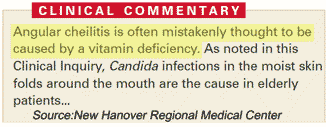 Instead,
a lack of vitamins makes the body's immune system weaker which makes it
more prone to illnesses such as angular cheilitis. Unfortunately, many
individuals still believe that a vitamin deficiency causes angular
cheilitis which is not true.
Instead,
a lack of vitamins makes the body's immune system weaker which makes it
more prone to illnesses such as angular cheilitis. Unfortunately, many
individuals still believe that a vitamin deficiency causes angular
cheilitis which is not true.
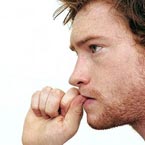 Spread of Bacteria – These things cause the bacteria to spread from your mouth/face to your lips.
Spread of Bacteria – These things cause the bacteria to spread from your mouth/face to your lips.
